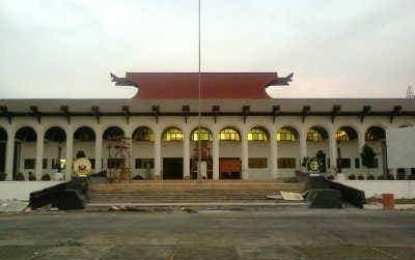
The administrative building of the Bangsamoro Autonomous Region in Muslim Mindanao in Cotabato City. (Photo by BPI-BARMM)
COTABATO CITY – Several local government units (LGUs) n Lanao del Sur and Maguindanao are now using thematic overlay maps as graphic indicators for 2019 coronavirus disease (Covid-19) hotspots, among others.
The new tools were made possible through the help of International Alert Philippines (IAP), a peacebuilding non -government organization, which produced the large format printed digital maps.
The maps show the spatial features of provincial, municipal, and barangay boundaries, road and river networks, geohazard vulnerabilities, and conflict flashpoints in the Bangsamoro Autonomous Region in Muslim Mindanao (BARMM).
“Places where Covid- 19 cases emerge or are concentrated, can then be superimposed into these maps, enabling LGUs to respond more effectively and quickly to areas and communities where virus infections, local vulnerabilities, and violent tensions and pressures converge,” the IAP said in a statement Monday.
IAP further said that local Covid-19 inter-agency task forces using the advanced maps in the BARMM so far are the LGUs) of Marantao, Piagapo, and Saguiaran in Lanao del Sur, and also the LGUs) of Parang, Barira, Buldon, and Matanog in Maguindanao.
Najib Zacaria, municipal disaster risk reduction officer and operations chief of Marantao, Lanao del Sur, reported that the physical maps with satellite imagery helped him and his team identify patients under investigation (PUIs) and persons under monitoring (PUMs) in the area.
“The maps also ensured that we were covering all the communities in our outreach areas, thereby preventing complaints and disputes,” Zakaria said.
May Quesada, municipal planning and development officer of Parang, Maguindanao, said that the maps enabled the Barangay Health Emergency Response Team (BHERT) to mark communities where the PUIs and PUMs are from and locate the nearest rural health units as possible isolation facility.
Nikki de la Rosa, IAP country manager, said that the maps were crafted from the outputs generated during a series of resource use and management planning (RUMP) workshops conducted in the aforementioned areas in 2019.
The RUMP program seeks to enable communities to employ geographic information system mapping technology in assessing local resources, surface land-related issues, and agree on utilization strategies informed by local conflict dynamics.
“The conflict maps included in the compendium provide information on conflict incidents and causes, whether these are violent extremist incidents, clan wars, illegal-drugs, and illegal-weapons related, common crimes, or killings related to political contestation,” De la Rosa said.
Saripada Pacasum Jr., head of the Early Response Network of Lanao del Sur (ERN-LDS) noted that they are seeing tensions rise because the virus has taken away the capacity of people to earn, deepening the hardship of people in Marawi who are already impoverished by war and displacement.
“Credible data should be the backbone of any planning and monitoring activity. The maps will certainly help planners allocate limited human and funding resources well,” Pacasum said.
ERN-LDS, a partner of IAP, is composed of local disaster risk reduction officers and volunteers across the province that monitors critical events in their localities and coordinate response to natural and human-induced disasters.
The IAP, which has been working alongside LGUs in the BARMM on various initiatives, receives funding support from Australia’s Department of Foreign Affairs and Trade. (PNA)
